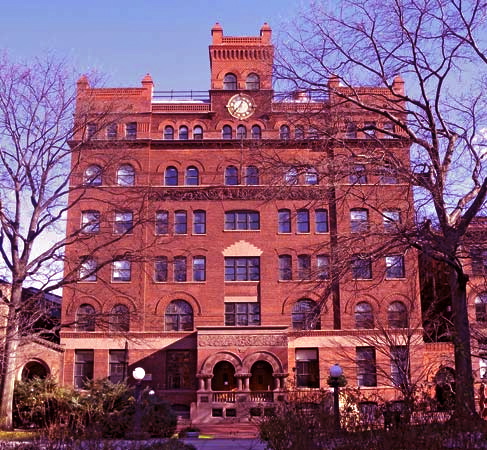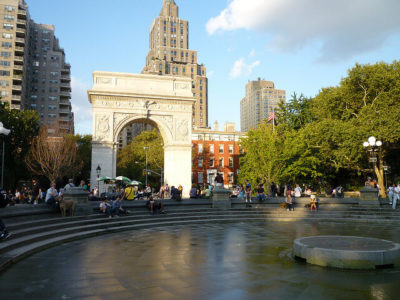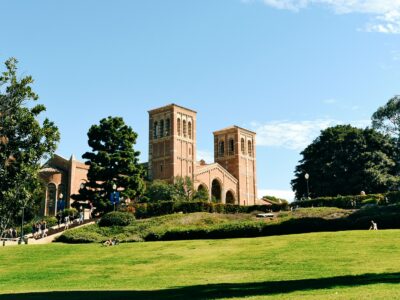Do you ever dream of designing the next Guggenheim or Lincoln Center? Do you love how buildings connect a city? With a degree in architecture, you can be the one behind the blueprints. Architects flourish working with innovative technology, contractors, city standards and their own creativity. Inspiration for the new piece of a city’s history can come from anywhere–the landscape, a piece of artwork or the current state of our political environment. But where do you go to learn how to construct this inspiration into actual buildings? These 10 universities feature faculty expertise, unique course offerings, masterful architecture just around the corner and hands-on career opportunities that can help you unlock your passion for architecture.
Check out the top 10 schools to make your architecture dreams come true.
10. Parsons School of Design

Beyond the glitzy skyscrapers that fill New York City lies the art and design college Parsons School of Design. The school’s mission recognizes the importance of environmental methods of building. Coming to Parsons with curiosity in multiple aspects to design won’t weigh you down–classes in the architecture program range from industrial design, interior design and lighting design. The in-depth courses like Objects as History, Materiality and Assembly: Environmental Technology and Computer-Aided Industry Design teach you about the history of building materials and the valuable skills the industry needs. At Parsons, the faculty-student ratio in the architectural program averages nine to one. You know what that means? A thoroughly looked-over portfolio by the time you graduate. To build a career professionally in architecture, Parsons partners with leading firms like Diller Scofidio + Renfro and Material Connexion to help you get your foot in the door. Your education awaits you in the city of aspirations as huge as the skylines where your entrance is as powerful as your exit.
9. University of Miami

On the sands of the Coral Gable, the University of Miami offers an architectural education by the shimmering Atlantic. At Miami, you capture the essence of the city with jaw-dropping modernist structures. Just check out the Miami Car Park by the architect Zaha Hadid and the prismatic 14-story tower by Jeanne Gang. Whenever you feel a creative block, a drive or walk by those structures brings you a step closer to finding new meaning in your assignments. The variety of courses–like Environmental Building Systems, Ancient Architecture and Colonial Architecture–will bring you full circle from the ancient to the modern-day structures. Open City Studio gives students studying architecture or urbanism the opportunity to workshop abroad, exposing students to popular culture and folklore in cities like Cape Town, Mumbai and Kyoto. The University of Miami prides itself on its encouragement for students to question, criticize and discover everything about architecture. Students who have a mindset geared toward changing and designing their own communities have a chance to strive through the Community & Regional Planning Club. The social events and conferences with a focus in career development connect students to use their skill sets in their local communities. The glamourous beaches of Miami make your education feel like a four-year vacation to bring out the best of your creativity for all your architecture dreams.
8. Iowa State University

Did you know Iowa State University was one of only three colleges to receive the American Society of Landscape Architects Medallion Award? Not too shabby. Given to outstanding landscape sites, the award reflects ISU’s breathtaking nature walks right on campus that delivers a dose of daily ease. In the city, check out the High Trestle Trail Bridge to explore five cities in Iowa (Ankeny, Madrid, Slater, Woodward and Sheldahl) for sightseeing and a healthy walk. Or for new architectural inspiration in the Midwest, check out the recently completed modernist-styled American Enterprise Group Corporate Headquarters. For students who prefer big classroom environments with chances of making more friends, ISU’s architecture program averages nineteen to one. You can connect with others through the College of Design Art Club and Community & Regional Planning Club to talk about your ideas. “Architecture is a social discipline and the ability to work together and leverage technology is paramount to their ability to flourish,” Iowa State University Senior Associate Dean Cameron Campbell said. “Parallel to this is space for things like cafe, reading room (with periodicals and reference). Technology is innovation space with sandbox areas, access to tools and the resources to operate safely.” To continue your architecture education elsewhere, Iowa State University’s architecture department offers study abroad in Venice, Berlin and Rome.
7. Carnegie Mellon

Carnegie Mellon University centers in the historic city of Pittsburgh, known for its integral roles in the American Revolutionary Wars, Civil War and the legacy of steel industry philanthropist Andrew Carnegie. “Carnegie Mellon’s School of Architecture provides deep immersion in a culture of interdisciplinary innovation and creative inquiry,” Carnegie Mellon Professor of Architecture Stefan Gruber said. Sitting in on classes like Mesoamerican and Spanish Colonial Architecture of Mexico and Guatemala and Architecture Preservation brings the best of curiosity, history and imagination. “Beyond training students to design buildings and cities that promote community and planetary well-being, we challenge them to redefine our discipline and current modes of practice. By taking our students out into neighborhoods and working directly with and for communities, we make them humbler in how they go about pursuing transformation,” Gruber said. If doing good for the local community while building your resume enhances your college experience, the Urban Design Studio at Carnegie Mellon gives you the opportunity to collaborate with faculty to design affordable and replicable structures. Sink yourself into the American Institute of Architecture to enrich your collaborative experience in architecture.
6. University of Southern California

The Romanesque revival-style campus located in the heart of downtown Los Angeles makes University of Southern California hard to miss in the inner city. USC’s prime location has a metro station on campus which connects to the rest of downtown, making it easy to get around. As a student, you can find inspiration everywhere–on a walk around campus and in the skyscrapers downtown. Make sure to see Pershing Square, The Cooper Building and The Staples Center. Modern lovers of architecture rejoice with modernity-centered coursework in topics like Contemporary Asian Architecture and Global Economic Architecture. University of Southern California brings the global workforce for young architects with internships abroad in countries like China, Japan, Italy and Spain. If personalized attention means a lot for your academic growth, the USC School of Architecture has a faculty to student ratio with an average of eight to one. Best of all, the student environment welcomes almost every activity possible. “USC students are fun, there are hundreds of student organizations on campus, no matter your interest, you will find a club you belong to,” University of California alum Lin Dykstra said. “When I was in USC, I was a loyal member of US-China Institute, working on a newspaper called China Today covering both social issues both in China, over there I met many of my best friends. They really developed my critical thinking, writing skills and my interpersonal skills.” University of California alum Lin Dykstra said. As the future of architecture looks at alternative energy to fossil fuels in architectural planning, USC hosts the Energy and Environmental Law Society which appeals to those conscious of the environment. Participate to learn how to apply current environmental ethics laws and ideas to your projects. At USC, the relaxed SoCal vibe meets the glimmering towers of Los Angeles to make your four years of architectural ambitions a breeze.
5. University of Notre Dame

Tie your mindset to your imagination at the University of Notre Dame. After all, the balance of practicality and innovation is what architecture is all about. The University of Notre Dame has strong course offerings in understanding architecture from a variety of skills with classes like Byzantine Art & Architecture, Analysis of Architectural Writing, Advanced Furniture and Roman Urbanism and Architecture. “In this university context, daily life in the School of Architecture first entails learning substantive skills, including drawing, composition, the properties of building materials and their assemblage, and learning the nature, history and ends of both architecture and cities; and second, engaging in intellectual dialogue and debate with both student and faculty colleagues,” University of Notre Dame Professor of Architecture Philip Bess said. If you have a passion for Ancient Rome, why not study abroad? You can take in the Arch of Titus, Roman Temples, Arch of Constantine and much more through the study abroad program. At the University of Notre Dame, the respectful attitude towards culture and design brings the best moral and intellectual compass to each student. Students can showcase their work in the Student Gallery, where that student project has the potential to turn into a reality. “At Notre Dame’s best, we reason together in modes artistic, empirical and moral, across scales domestic-to-regional and microcosmic-to-cosmic, toward ends beautiful, good, and true,” Bess said. Notre Dame combines both farming and modern industries to bring a midwestern comfort to your college experience.
4. Pratt Institute

At the Pratt Institute, the city of New York lies at your fingertips. Both the Brooklyn and Manhattan campuses offer a wide variety of motivation for your creative spirit, from the art deco found at the Chrysler Building in Manhattan to the modernist design of the William Vale Hotel in Williamsburg. The Brooklyn campus at Higgins Hall offers programs in architectural workshop and studio while the Manhattan Center focuses on management coursework. The hub of architecture known as New York fascinates students’ eyes with the latest trends in modern architectural design. Want to escape the big city? Explore architecture around the world through classes like Building Services, Islamic Architecture and Pre-Colombian Architecture. The small class ratio of 9:1 student to faculty ratio increases your chances of establishing close relationships with your professors. Students have countless opportunities to network with each other and build professional contacts through student organizations in architecture like American Society of Interior Designers and the Center for Career and Professional Development. If the trends of the Asian economy interest you, the Pratt Chinese Architecture Alliance helps build professional relationships between the United States and China. Faculty at Pratt Institute have their own specialties to help you figure out what exactly you want to design. Interested in medical and surgical facilities? Study under Professor of Architecture. Want to know what it’s like to do architecture work in South Korea? Pick Professor of Architecture Farzam Yazdanseta’s brain. You can even talk to Professor Richard Yoo about what it was like to co-design the Triangle Shirtwaist Fire Memorial in New York City. The educational experience merging both sides of New York lets you find inspiration on every corner.
3. California Polytechnic State University, San Luis Obispo

If city life doesn’t fit into your dream campus environment, check out Cal Polytechnic State University, San Luis Obispo.. The coastal town of San Luis Obispo, California, hosts extraordinary sites in valleys, farms and vineyards. The architectural styles have a Spanish presence, speaking to the history of the county, founded by Spanish Franciscans in the 1700s. Students can even find inspiration at the Geodesic Dome built by Cal Poly students in Poly Canyon Design Village. California Poly stresses hands-on learning as part of their curriculum while promoting students to take coursework outside of their major. The more diverse interdisciplinary work, the better. “Cal Poly San Luis Obispo is a highly selective university with a ‘Learn by Doing’ philosophy that emphasizes learning through direct experience in the practice and application of knowledge,” Cal Poly San Luis Obispo Professor of Architecture Doug Jackson said. “The Cal Poly Architecture Department shares this philosophy and offers many unique experiences for its students to test their ideas in various media and at various scales–up to and including full-size prototypes.” This highly competitive public school has a school of architecture size of only 189. Designing architectural edifice requires creating an innovative structure to speak to society by deliberately incorporating technology, society and culture. Cal Poly’s coursework allows students to hone the skills needed to become an architect while becoming well-rounded in multiple fields of study.
2. University of Texas at Austin

Curiosity, academia and southern charm all coalesce at the University of Texas at Austin. The plentiful structures on campus and in the city inspire students’ minds. In recent years, private homes take the spots for the most compelling buildings in Austin like the Victorian styled Casewell House found west of campus. However, the endless options of excellent buildings worthy of a visit. “The campus of the University of Texas has the best collection of buildings, most notable of which are Battle Hall by Cass Gilbert, The University Tower by Paul Cret, and in town there is the United States Courthouse by Mack Scogin Merrill Elam, Architects, Austin City Hall, by Antoine Predock Architects, as well as the Austin Central Library, by Lake Flato Architects,” University of Texas at Austin Professor of Architecture Kevin Alter said. For career development as a leading architect, the twice-a-year Professional Residency Program offers students support with their resumes, applications and portfolios while building practical architecture skills in project management, construction observation and landscape design. Ultimately, the program helps you craft a list of architecture firms to your architecture style for your first full-time architecture job. At UT Austin faculty work as practicing architects, granting students the opportunity to learn from the pros and work aside them professionally and academically.
1. Virginia Tech
Do you dream of student life in an environment close to our nation’s history? In Blacksburg, Virginia, the mix of architectural styles represent the beginnings of this country like colonial, Gothic and Greek found in the historic district. Just a few hours away from Mount Vernon, the Governor’s Mansion, the Lynchburg Courthouse and the Shirley Plantation, Virginia Tech centers itself in early American history. The architectural program at the university has individual and group focused studios for students to flourish collaboratively and individually. “In the Virginia Tech School of Architecture and Design, there are many different projects outside the studio to get involved in,” Virginia Tech senior Aria Hill said. “For instance, as a second-year architecture student, I was afforded the opportunity to join the AIA Upjohn-funded Bamboo Retooling Research team of Katie MacDonald, Kyle Schumann and Jonas Hauptman which focused on utilizing digital processes, specifically CNC milling, to reconfigure the strong but light material of bamboo into a sustainable building material.” Course offerings include Innovative Design Thinking, Building Cities, and Ideas, Concepts and Representations of Architecture. Virginia Tech recognizes the need for students to have awareness of modern technology with their semester-long professional residency program in Chicago. As a student you will have the opportunity to live in downtown Chicago and work in a group on projects within the city. Not only do you gain skills in design, but you learn real life logistics of handling the social climate of a city, group meetings with local community leaders and gain relationships with Chicago’s business and political leaders who shape urban design policies. Before you know it, your well-versed knowledge in Early American architecture will bring out your inner historical nerd.



















